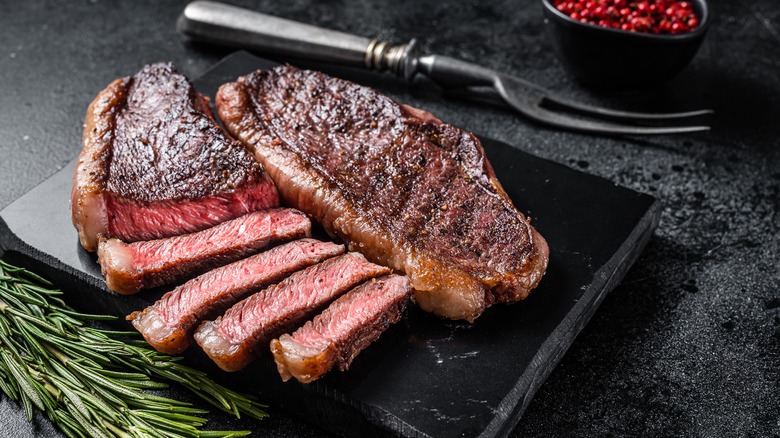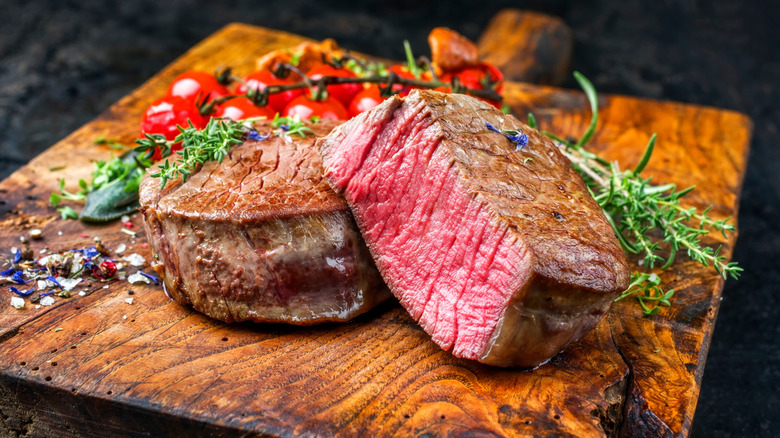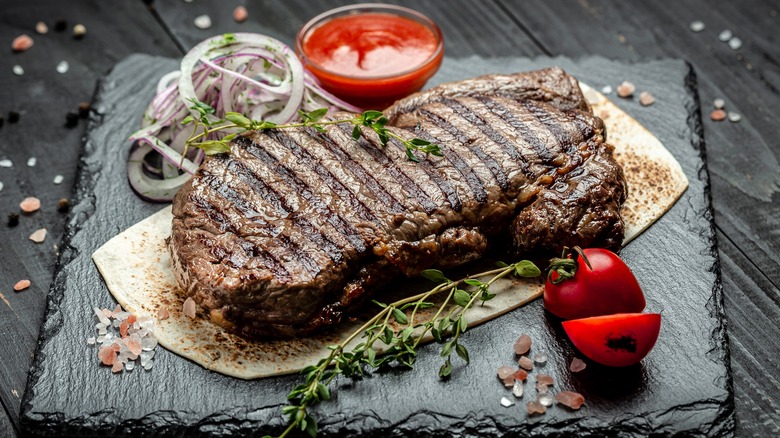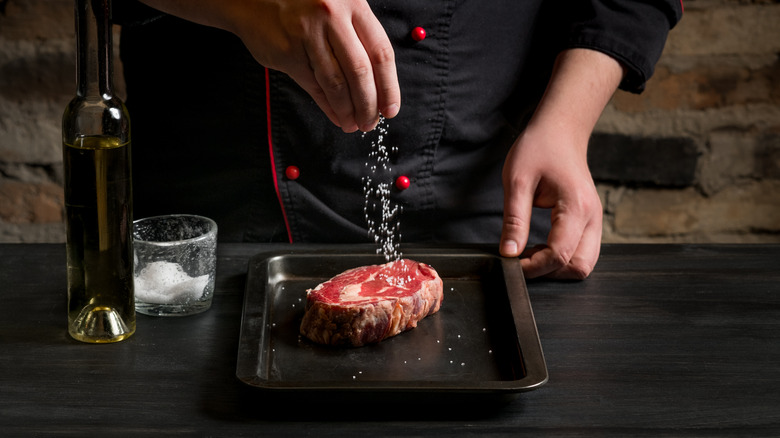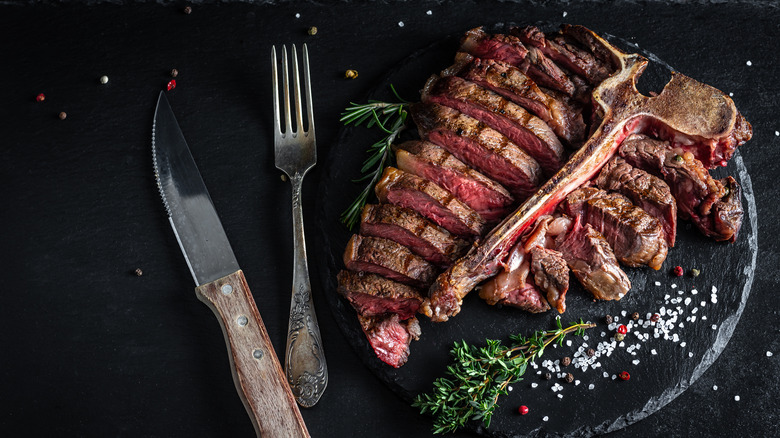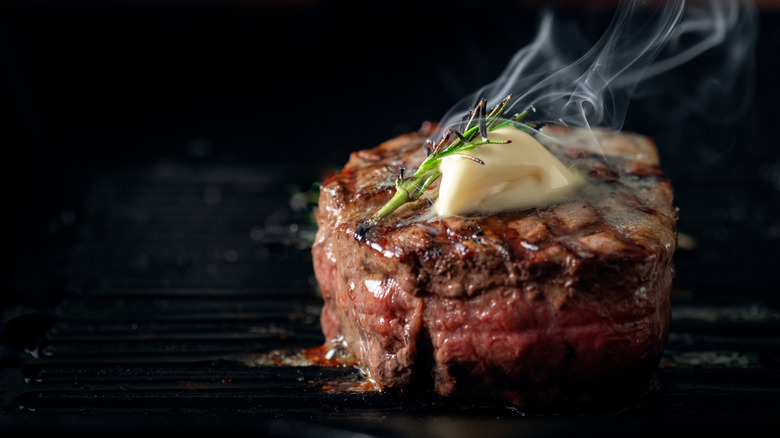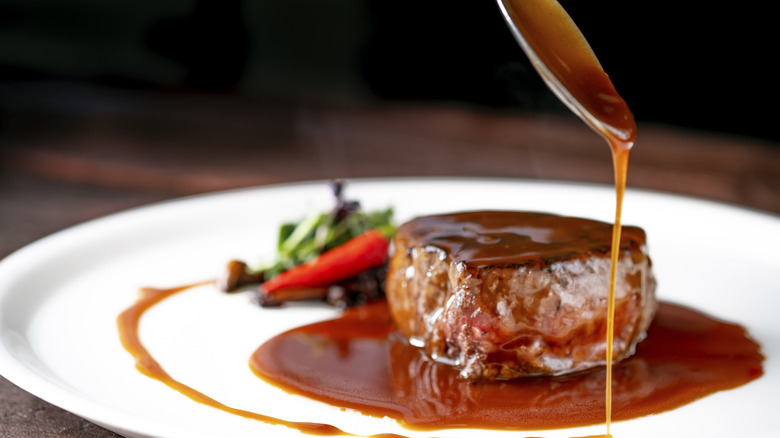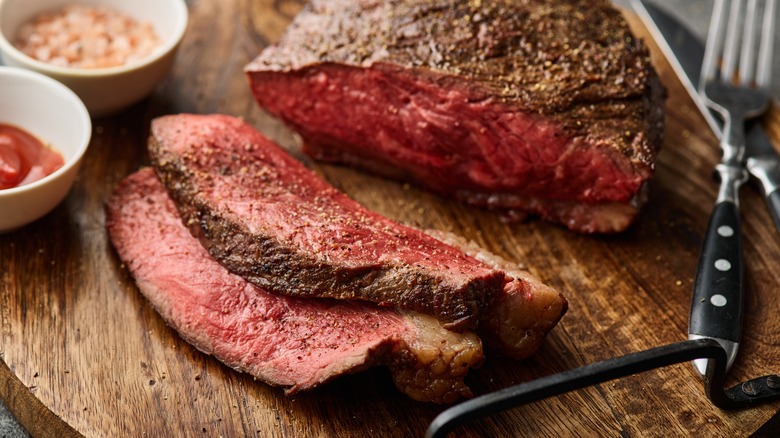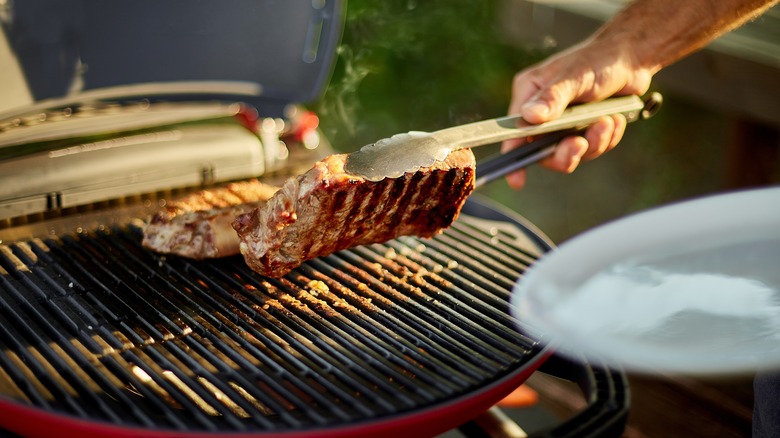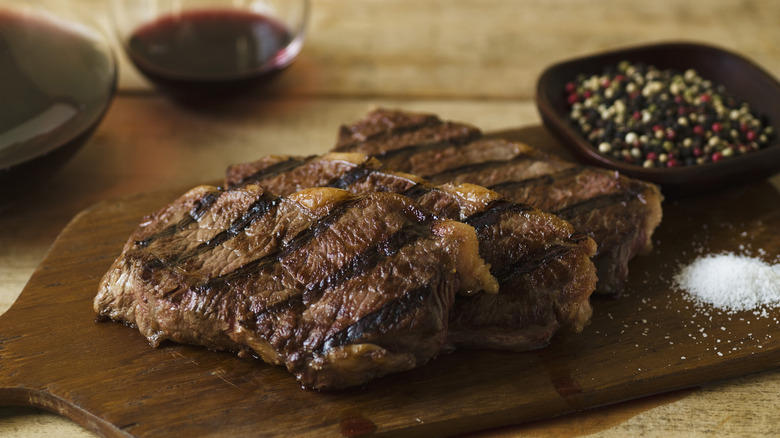9 Delicious Benefits To Reverse Searing Steak
There are many different ways to cook a steak. You can grill it, pan-sear it, sear it in the oven, or cook it sous vide, to name a few. However, there is one lesser-known method that will make cooking a steak easier than ever before, and once you try it, chances are you will stick with it from that day forward.
Reverse searing is a cooking method where the steak is placed in an oven set to a lower temperature, slowly brought up to the desired internal doneness, and then quickly seared in an extremely hot pan on the stovetop to generate a deep brown crust. There are a wide array of benefits to reverse searing a steak ranging from convenience and reliability to overall quality and taste.
It goes without saying that steak can be pricey. Especially larger, higher-quality cuts like ribeyes or filets come with a significant monetary investment. So, making the most of that steak, and your hard-earned money, is important, and cooking a steak is not always as simple as it seems. There are many variables to consider, such as controlling the heat, monitoring the internal temperature, the resting period, and so on.
Luckily, reverse searing removes most of these variables and makes the ones that remain easier to manage. Here are the many advantages of reverse searing that will help you get the best out of your next steak.
Even and precise cooking
The most fundamental difference between a good steak and a not-so-good steak is uneven cooking. No one likes to cut into their steak and see half of it pink and half of it grey. Simply cooking a steak on the grill or in a pan is obviously doable, but it is more difficult to manage and requires far more attentiveness. Cooking a steak sous vide will yield a perfectly even-cooked steak every time, but not everyone has access to an immersion circulator. So, reverse searing is the way to go.
This is the reason why reverse searing should be done in a low-temperature oven. The steak will slowly and steadily come up to the desired temperature, and you can remove it from the oven as soon as it does. After a quick, intense sear in a pan or grill, the interior of the steak will be exactly where you want it. No matter how you like your steak cooked, reverse searing gets the job done without sacrificing a crusty exterior.
Another great reason reverses searing's precision makes it a superior steak cooking method is that you can cook individual steaks to individual preferences. Suppose you like your steak medium-rare, but a friend or family member prefers theirs medium-well. In that case, you can cook both steaks simultaneously, bringing each of them up to that precise temperature so you can keep everybody happy, which is what cooking is all about anyway.
Better crust
A deep brown crust on a steak relies on the moisture of the steak when introduced to direct heat. This is called the Maillard Reaction, according to Masterclass, which occurs when a meat protein is introduced to heat and caramelizes.
The reason why a crustier outside is more easily achievable with reverse searing is that the moisture of the steak's exterior is removed from the cooking time in the oven. Getting a deep brown crust from a regular sear is possible, but there will always be leftover moisture on a raw steak, no matter how well you pat it dry. This is why searing a raw steak in the pan or grill can result in the steak turning out grey. If it retains too much of its moisture before an introduction to heat, the Maillard Reaction will not be able to occur before the interior of the steak is done cooking.
Reverse searing cooks the whole steak first. Therefore, after removing it from the oven, all that is left to do is put a deep brown crust on it. This is made much easier because with the steak's exterior already thoroughly dried out, the Maillard Reaction can begin the second it hits a hot pan or grill. This is why the final sear should take no longer than thirty seconds for each side. If the pan is hot enough, a delicious, caramelized crust can be formed without the evenly done interior cooking any further.
It's easy and effective
Another reason reverse searing a steak should be your go-to method is that it removes all the stress from cooking it. As mentioned earlier, there are many variables at play when cooking steak, and it could be difficult to control them. Plus, variables such as heat are very time sensitive. Any extra exposure, not enough exposure, or an inconsistent amount of heat will result in an unevenly cooked interior, and the steak you have spent money on and looked forward to will end up subpar.
Reverse searing a steak controls the temperature for you. The preheated oven keeps this variable constant for the entire cooking process so you can sit back and relax or turn your attention to side dishes, desserts, or entertaining company. As long as you stay mindful about your steak in the oven and consistently check its temperature around the time it is scheduled to be done, the reverse sear is the lazy cook's technique.
The best part is, however, that reverse searing does not yield lazy results. Instead, it allows you to produce steakhouse-quality results with a fraction of the effort. The inside will be juicy and tender, and the exterior dark and crusty. It's consistent, it's reliable, and it's a straightforward avenue toward delicious steak.
Any cut of steak can be reverse seared
Different cuts of steak require contrasting cooking methods. Cuts of beef that are very lean and do not have a lot of fat on them require longer cooking times at lower temperatures so that the muscle fibers do not constrict and become tough, chewy, and difficult to eat.
Other cuts, however, thrive on a shorter cooking time on high heat. These include cuts that have a higher fat content and a better marbling of that fat, meaning the fat on the steak is dispersed throughout the cut instead of concentrated in certain locations. These cuts are better cooked this way because when the fat renders, it keeps the muscle soft.
There are cuts of steak that are better fit for different cooking methods, but reverse searing will do the vast majority of steaks justice. The best cuts of steak for reverse searing are, however, thicker cuts, about one inch thick, according to My Chicago Steak. These include ribeyes, chuck eyes, filet mignon, New York strip, hanger steak, porterhouse, and some cuts from the round primal.
The low cooking temperature inside the oven will help keep the muscle relaxed throughout the cooking process, resulting in a more tender cut of beef regardless of fat marbling. Still, very thin cuts like skirt steak, flat iron, bavette, and others, which can technically be reverse seared, are probably better off cooking entirely on direct heat.
You can baste the steak with whatever you like
Reverse searing also presents a great opportunity to add whatever flavors you like to your steak. While marinades and specific seasonings are the most typical methods for doing so, basting our steak throughout its time in the oven will not only keep it juicy and moist but also deepen its flavor.
The most classic flavorings for steak are normally some combination of garlic and thyme. A great way to utilize these flavors is with compound butter. This super easy-to-make condiment goes a long way, especially for steaks. Simply bring some butter to room temperature and add finely chopped garlic, thyme, and salt to taste.
Then, periodically, baste the steak with the compound butter throughout the cooking process. Just remember to pat the steak dry before the final sear. These flavors both complement the natural beefy flavor of the steak as well as infuse it with the added richness of the butter to reinforce the fat to keep it tender.
This is just one example of what you can baste your steak with. You can add other seasonings like red pepper flakes, herbs, or whatever ingredients you like. This recipe for Korean-inspired compound butter includes soy sauce (a natural tenderizer), Korean chili flakes, and ginger, resulting in a combination packed with umami flavor.
It's fit for the grill or skillet
Once your cut of steak has reached your desired internal temperature, all that is left is to give it a nice crust. When this is all that is required, time is of the essence. This is why cast iron skillets are the preferred pan for searing for various reasons, but most of all, they are an excellent conductor of heat. So, pre-heating your cast iron skillet ahead of time will allow it to not only get very hot, the thickness of the skillet will do what it does best and retain that heat and distribute it evenly throughout itself. This makes for an ideal environment for searing, as the exterior will be browned evenly and quickly.
The grill is also an entirely welcome method as well for obvious reasons. The stamps of charred goodness left on the meat from the grill grates are not only pleasing to the eye, but it also contributes to a flavor you can only get from a grill. Plus, closing the lid while searing infuses the meat with the smoke of the grill, adding another layer of unequaled flavor.
Pre-heating your cast iron skillet on the grill and searing your cooked steak directly inside, however, helps combine the best of both worlds, according to Field Company. An even sear across the surface makes for a more uniform crust throughout, and the enclosed grill environment provides that smoky, grilled flavor simultaneously.
Make a sauce with pan drippings
If you can access a quality steak cut, it is encouraged that you keep things as simple as possible. Cheaper, leaner cuts of steak are great vehicles for things like marinades or elaborate sauces, but well-marbled, more expensive steaks are best when out on their own pedestal. Unlike cooking a steak on a grill or doing so in a pan, reverse searing allows you to save the steak's drippings, which presents the opportunity for a simple yet delectable sauce to serve it with.
A pan-drippings sauce does not take away or overpower any natural flavor of a steak. Rather, it enhances it even further and helps it reach its maximum potential. As your steak cooks in the oven and the fat renders down, the excess fat falls off from the steak. This is also known as the fond, according to My Chicago Steak. The fond is the base for the pan sauce, which requires very few additions to make. This is why it is important that you place your steaks on a wire rack set in a baking sheet when they cook in the oven, so the drippings will be caught by the pan.
With the addition of some herbs, garlic, beef broth or red wine, and some butter, you can transform these drippings into an outstanding yet uninvolved sauce to serve with your steak. The beef flavor remains on center stage, with an award-winning supporting cast.
There is no need for resting
Normally when a steak is cooked, it should be left to rest for at least ten minutes before slicing into it. The reason why the resting period is so essential to your steak is that slicing it immediately does not allow the juices inside to redistribute.
If you do not let your steak rest, all of those delicious juices will just spill out when you dig in. Essentially, steak is not done cooking after it is removed from the heat, and the resting period is the final step of the cooking process.
While of the utmost importance, these few minutes of resting can be agonizing. You have looked forward to this steak, went out and bought it, seasoned it, cooked it, the smell of it is in the air, and all you want to do is dig in. Well, if you reverse sear your steak, you do not have to wait.
This is because the low temperature of the oven does not draw out the steak's juices to the exterior, so redistribution of those juices through resting is not necessary, per Kansas City Steaks. Instead, after the final sear and you pull your steaks off the grill or pan piping hot, you can dig into it immediately without ruining it. It is recommended, however, that you allow about five minutes of resting between removal from the oven and the final sear.
It can be done ahead of serving
Adding to the convenience factor of reverse searing steaks is how this method requires less attention than others, making it an ideal cooking method when entertaining. This is because the steaks can rest for up to an hour between being removed from the oven and the final sear, according to celebrity chef Jet Tila.
Therefore, if you have company over for a dinner party, a backyard cookout, or are just cooking steaks for a weeknight dinner, reverse searing allows you to focus on other things instead of sitting over the steak for the entirety of the cooking process. Not only can you step aside during the actual cooking of the steak in the oven and return only toward the end of it, but you also do so after the steaks are out of the oven. This will give you an opportunity to prepare side dishes, socialize, or even run an errand or take care of an entirely different task.
Then, once it is time to eat, you can gather your steaks, crank up the heat, preheat a skillet or grill, and finish the main course in a couple of minutes. Remember, you can dig into them immediately after!
Tips for reverse searing
First, remember to take your steaks out of the refrigerator ahead of time and allow them to come up to room temperature before cooking. This will expedite the cooking time and ensure even cooking as well. An important tip for reverse searing steak is to make sure you have the right kitchen tools for the job. Reverse searing is very minimal, but the right equipment will make the process much easier.
You should also ensure that you have a wire rack that can fit inside a baking sheet. Cooking your steaks in the oven while directly on the sheet will cause them to cook unevenly, as direct contact with a heat source will throw off the cooking process. Plus, as mentioned earlier, this baking sheet will catch the steak drippings with which you can make that delicious sauce.
You will also need an accurate meat thermometer. While it is possible to tell the internal doneness solely by feel, it's always best to have a thermometer ready just to be sure since precision is the main benefit to reverse searing. If you can get your hands on an oven-safe thermometer that allows you to read the temperature from the device outside, even better. Then, as soon as it reaches the right temperature, you can take it out.
Finally, don't rush the process! It may take longer than other steak cooking methods, but reverse searing is well worth the wait.
